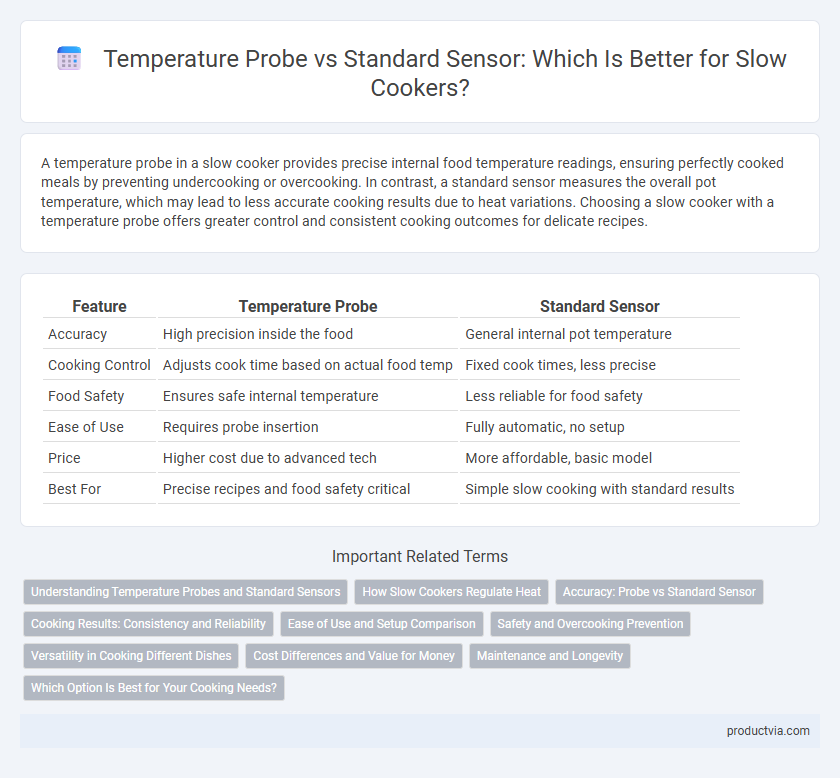A temperature probe in a slow cooker provides precise internal food temperature readings, ensuring perfectly cooked meals by preventing undercooking or overcooking. In contrast, a standard sensor measures the overall pot temperature, which may lead to less accurate cooking results due to heat variations. Choosing a slow cooker with a temperature probe offers greater control and consistent cooking outcomes for delicate recipes.
Table of Comparison
| Feature | Temperature Probe | Standard Sensor |
|---|---|---|
| Accuracy | High precision inside the food | General internal pot temperature |
| Cooking Control | Adjusts cook time based on actual food temp | Fixed cook times, less precise |
| Food Safety | Ensures safe internal temperature | Less reliable for food safety |
| Ease of Use | Requires probe insertion | Fully automatic, no setup |
| Price | Higher cost due to advanced tech | More affordable, basic model |
| Best For | Precise recipes and food safety critical | Simple slow cooking with standard results |
Understanding Temperature Probes and Standard Sensors
Temperature probes in slow cookers provide precise internal temperature readings by directly measuring the food's core heat, ensuring accurate cooking and preventing overcooking or undercooking. Standard sensors typically monitor the ambient temperature inside the slow cooker's pot, which can result in less precise control over the actual food temperature. Understanding these differences is crucial for selecting a slow cooker that delivers consistent, safe, and ideal cooking results.
How Slow Cookers Regulate Heat
Temperature probes in slow cookers provide precise, real-time internal food temperature monitoring, allowing the appliance to adjust heat output accurately. Standard sensors typically measure the ambient temperature inside the cooking pot, which can lead to less precise heat regulation and longer cooking times. Advanced temperature probe technology enhances cooking consistency and food safety by maintaining optimal heat levels throughout the slow cooking process.
Accuracy: Probe vs Standard Sensor
Temperature probes provide superior accuracy for slow cookers by directly measuring the internal temperature of the food, ensuring precise cooking without guesswork. Standard sensors typically monitor ambient heat inside the cooker, which can lead to inconsistent results and under- or overcooked meals. Using a temperature probe enhances cooking reliability, maintaining optimal food safety and texture.
Cooking Results: Consistency and Reliability
Temperature probes in slow cookers deliver more consistent and reliable cooking results by continuously monitoring the internal temperature of the food, preventing overcooking or undercooking. Standard sensors typically measure ambient pot temperature, which can cause fluctuations in cooking times and uneven heat distribution. Slow cookers with integrated temperature probes ensure precise control, enhancing texture, flavor, and overall meal quality.
Ease of Use and Setup Comparison
Temperature probes in slow cookers offer precise monitoring by measuring the internal temperature of the food directly, simplifying the cooking process and reducing guesswork. Standard sensors rely on ambient heat detection within the cooker, requiring users to estimate doneness based on time and general heat levels, which can be less accurate. The temperature probe design enhances ease of use by providing real-time, accurate feedback without complicated setup, while standard sensors generally involve simpler installation but less precision.
Safety and Overcooking Prevention
Temperature probes in slow cookers provide precise internal food temperature readings, significantly enhancing safety by ensuring meats reach safe cooking temperatures. Unlike standard sensors that monitor only the ambient pot temperature, probes prevent overcooking by allowing gradual temperature adjustments based on real-time data inside the food. This targeted monitoring reduces the risk of foodborne illness and preserves texture and flavor, making temperature probes a superior choice for controlled and safe slow cooking.
Versatility in Cooking Different Dishes
Temperature probes offer precise internal temperature monitoring, enabling perfect cooking of diverse dishes such as roasts, stews, and casseroles in a slow cooker. Standard sensors rely on preset heat levels, limiting adaptability and sometimes resulting in less accurate cooking outcomes for complex recipes. Using a temperature probe enhances versatility by allowing tailored cooking times and temperatures for various protein types and textures.
Cost Differences and Value for Money
Temperature probes in slow cookers typically cost more upfront than standard sensors but provide precise internal food temperature readings, enhancing cooking accuracy and food safety. Standard sensors offer basic temperature control at a lower price point, suitable for simple slow cooking tasks but may result in less consistent results. Investing in a temperature probe can deliver better value for money over time by reducing the risk of undercooked meals and optimizing cooking efficiency.
Maintenance and Longevity
Temperature probes in slow cookers offer precise internal food temperature monitoring, reducing the risk of overheating and prolonging the appliance's lifespan by preventing excessive wear on heating elements. Standard sensors often rely on ambient temperature, which can cause inconsistent cooking temperatures and increase maintenance needs due to thermal stress and sensor recalibration. Investing in a temperature probe system enhances slow cooker durability and minimizes maintenance interventions by delivering consistent, accurate temperature control.
Which Option Is Best for Your Cooking Needs?
Temperature probes offer precise internal food temperature readings, ensuring optimal doneness and food safety in slow cooking, ideal for recipes requiring exact thermal control. Standard sensors monitor the overall pot temperature, providing consistent heat but less accuracy in measuring the food's core temperature, suitable for traditional slow cooking methods. Choosing between a temperature probe and a standard sensor depends on whether you prioritize pinpoint cooking accuracy or straightforward temperature regulation for your slow cooker.
Temperature probe vs Standard sensor for slow cooker Infographic

 productvia.com
productvia.com